7.2 Gravitational Field Strength (symbol: g and units: N kg-1
or m s-2)
As seen in earlier section, the gravitational field strength acting at a
point in the field (previously depicted as M2 = 1kg) decreases
(illustrated by an increase in the field line spacing) as the point moves
further away from Earth. This means that field strength varies with
distance from the source mass (in this case, the Earth).
The gravitational field strength, g at a particular point in free space is
defined as the gravitational force per
unit mass acting on a point mass placed at that point.
7.2.1 Why point mass assumption:
Why must it be a “point mass”?
To simplify analysis, point mass are used as they are physically very
small so that the forces acting on different parts of the point mass are
generally the same.
7.2.2 g LO(C)
7.2.2.1 Equation
Based on Newton’s law of gravitation, the gravitational force acting on
the point mass, m by the source mass, M, (notice M1 is denoted
by M and M2 is denoted by m respectively)
---------------------------------------------------------- (1)
and gravitational field strength, g is the
gravitational force, F per unit mass acting on the point mass, m, we may
derive that the gravitational field strength.
Since we know the force on object as a result of the gravitational field
created by Earth is
F = mg
--------------------------------------------------------- (2)
putting the equations (1) and (2) together, we get
giving us the expression for gravitational field field g
7.2.2.2 Graphical representation
: The following shows the different g field strength at different positions
away from the mass M creating the gravitational field.
From left to right, for the case when M = 100 kg.
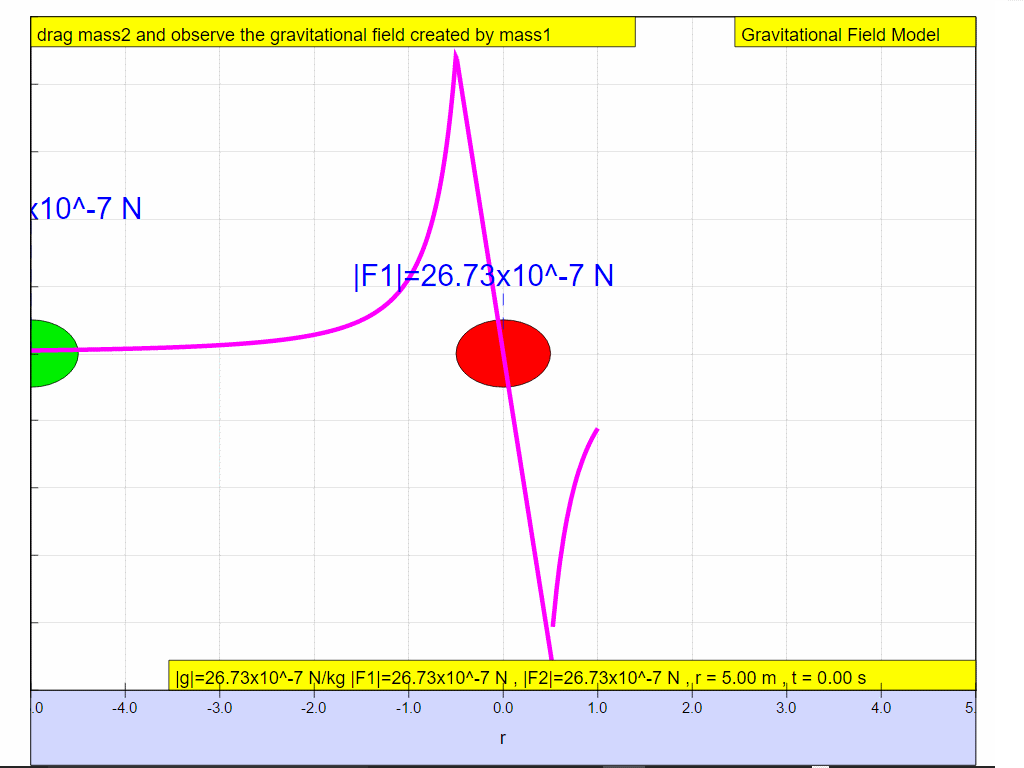
When r = -5.0 m, |g| = 2.673x10-6 N/kg towards M
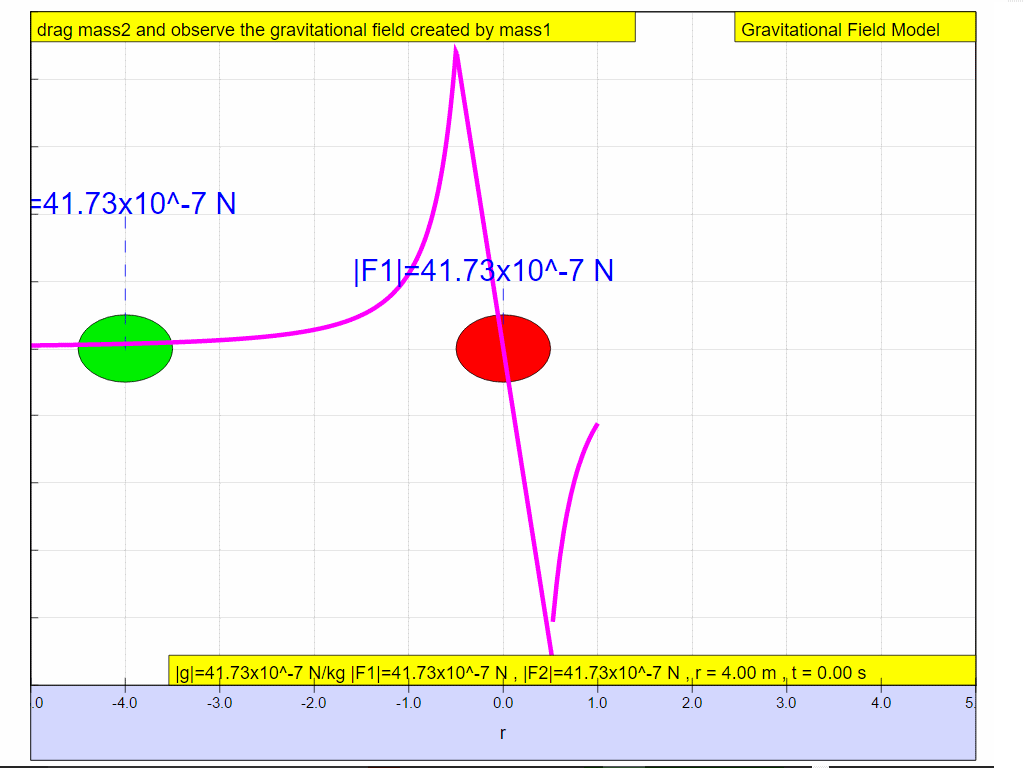
When r = -4.0 m, |g| = 4.173x10-6 N/kg towards M
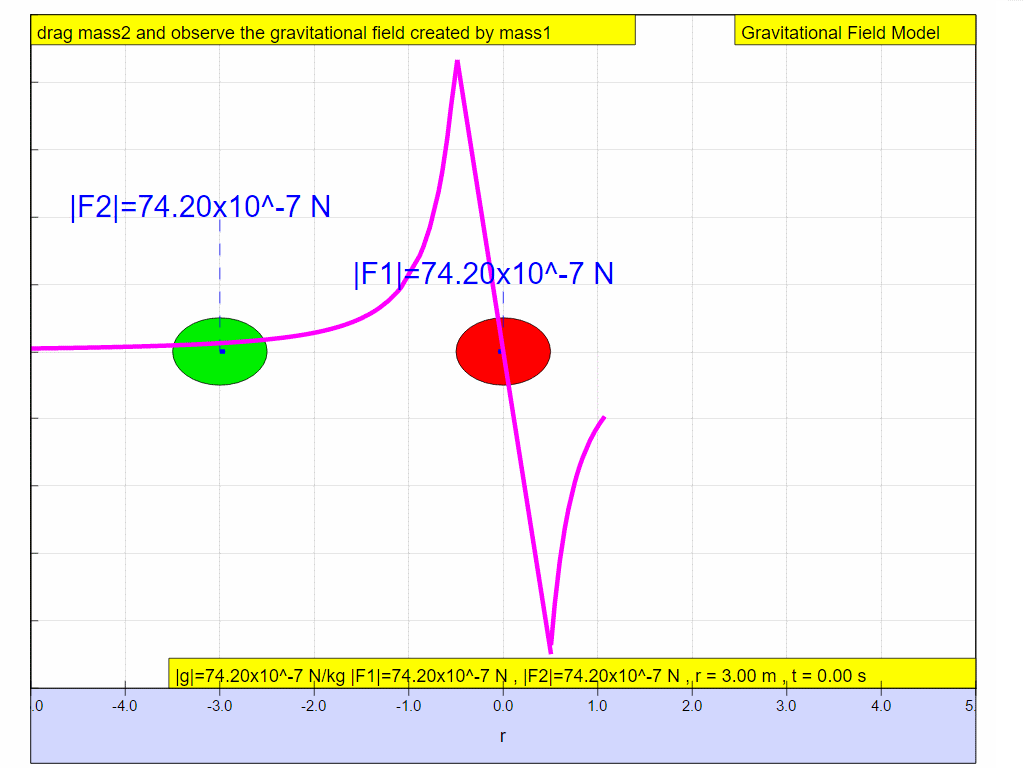
When r = -3.0 m, |g| = 7.420x10-6 N/kg towards M

When r = -2.0 m, |g| = 1.672x10-5 N/kg towards M
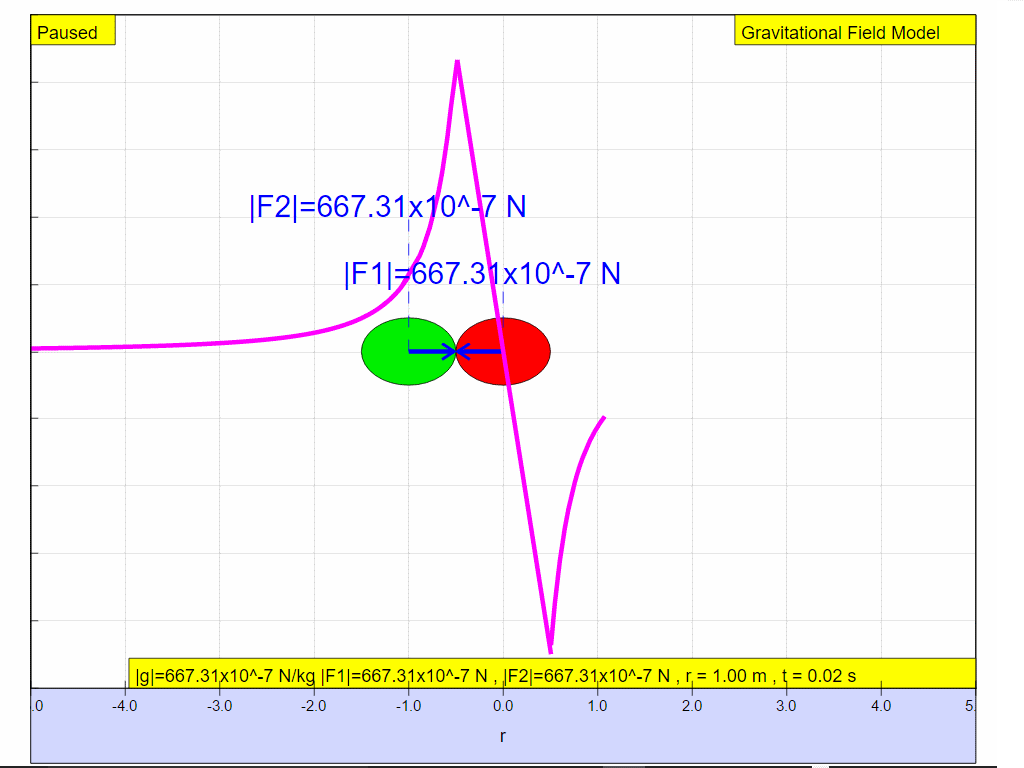
When r = -1.0 m, |g| = 6.673x10-5 N/kg towards M

When r = 1.0 m, |g| = 6.673x10-5 N/kg towards M
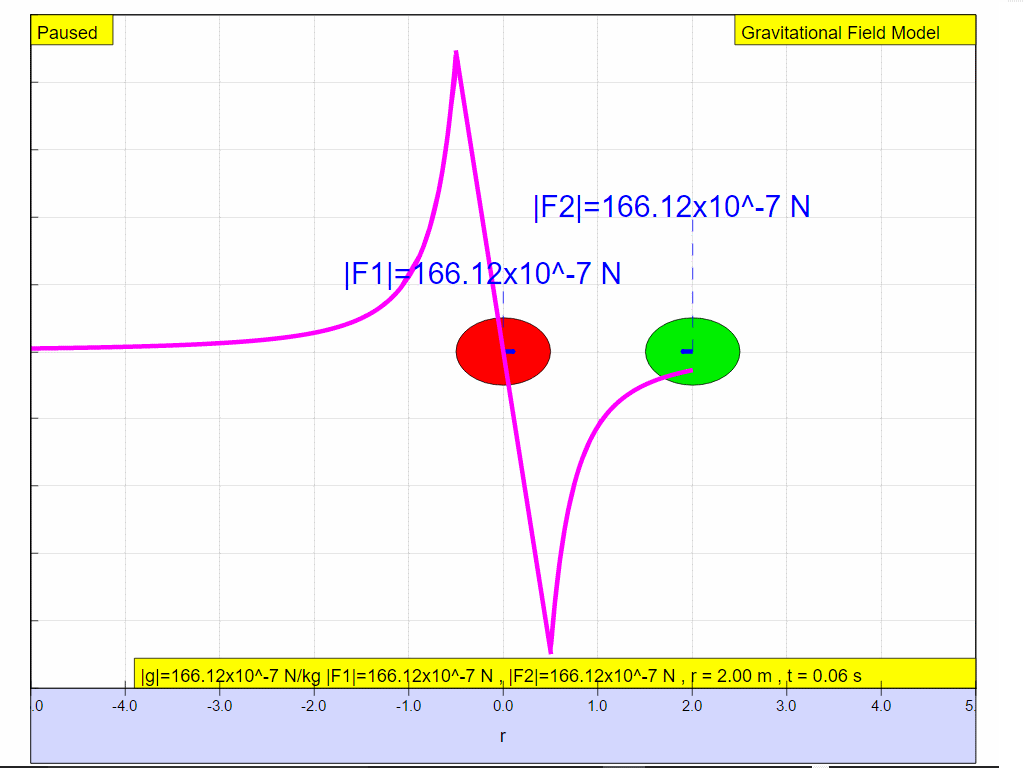
When r = 2.0 m, |g| = 1.66x10-5 N/kg towards M
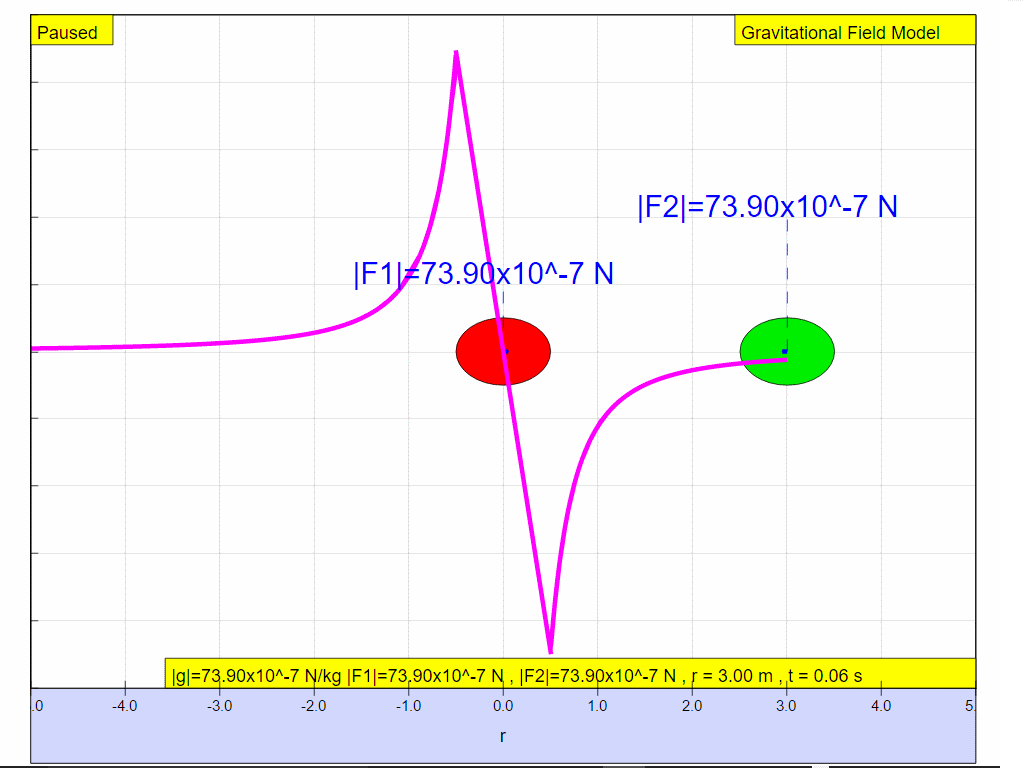
When r = -3.0 m, |g| = 7.390x10-6 N/kg towards M
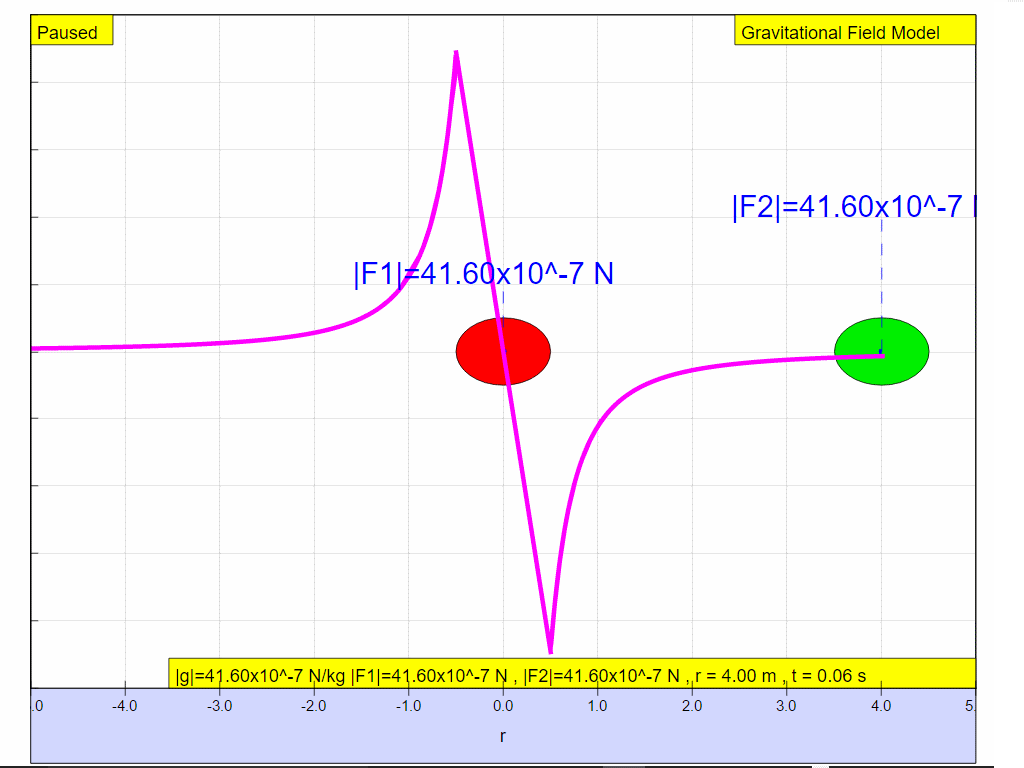
When r = -4.0 m, |g| = 4.160x10-6 N/kg towards M

When r = 5.0 m, |g| = 2.681x10-6 N/kg towards M
7.2.2.3 Vector Quantity
Suggest whether g field is a vector (possessing both magnitude and
direction) or scalar (possessing only magnitude, no direction) quantity.
1) Gravitational field strength, g (depicted as a magenta color curve) is
a vector quantity, and it
has a direction which is always towards the mass M.
7.2.2.4 Independent of test mass m
Try varying the values of the green test mass m, does it change the value of
g?
As shown in
, the
gravitational field strength of source mass M , g is independent of the mass
at that point, m.
7.2.2.4 Modeling activity with Simulation.
From the pictures above, how do the values of g changes with r?
Is the relationship linear, quadratic, inverse square etc?
Try your own model by keying an expression to test linear = "r", quadratic
= "r^2", inverse square = "1/r^2".
Which model seems to "fit" the g well?
7.2.2.4.1 gravitational field inverse square law field
The magnitude of the field strength , g varies according to the inverse
square law
.Hence
gravitational field is also known as an inverse square law field. In other
words as r increases, magnitude of g decreases according the formula
7.2.2.4.2 gravitational field points towards source mass M
• On the left side of the M =100-kg mass, the gravitational field
strength points to the right are positive values.
• On the right side of the M =100-kg mass, the gravitational field
strength points to the left are negative values.
The reason is because of the adoption of the Cartesian coordinate system
with positive x direction to the right.
Activity to do
Complete section (A) & (B) in ICT inquiry worksheet 1 using the EJS below to build your conceptual understanding on
gravitational field strength.
7.2.3 YouTube
https://youtu.be/nZSHpQmlddk
video tutorial to explain how to use the simulations for learning the
concepts
7.2.4 Inquiry:
An astronaut feels that he is ‘floating’ in a spacecraft in outer space as
the spacecraft rotates around the Earth at a distance of 4 x 107
m from the centre of Earth. He concludes that he is ‘floating’ because he is
not experiencing any gravitational field of the Earth. Suggest whether his
conclusion is right.
7.2.5 YouTube
https://youtu.be/_ikouWcXhd0
Resource Running in Space! by ReelNASA
7.2.6 Model:
The following suggested activity is recommended to allow students to use
mathematical equations or use the model field to propose a mathematically
valid equation to represent the gravitational field strength, g.
Hint: try typing in expression like 6.67*100/r^2 (left) and - 6.67*100/r^2
(right) separately.
Note that students do not note to key in x10^-11.
Note that the model field assumes G = 6.67 instead of 6.67x10-11,M
= 100 kg, r is the distance away from M (red gravitational field source
mass)
- https://dl.dropboxusercontent.com/u/44365627/lookangEJSworkspace/export/ejss_model_gravity04/gravity04_Simulation.xhtml
- http://iwant2study.org/ospsg/index.php/interactive-resources/physics/02-newtonian-mechanics/08-gravity/52-gravity04









